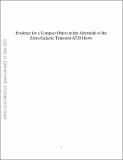Evidence for a compact object in the aftermath of the extragalactic transient AT2018cow
Author(s)
Pasham, Dheeraj R; Ho, Wynn CG; Alston, William; Remillard, Ronald; Ng, Mason; Gendreau, Keith; Metzger, Brian D; Altamirano, Diego; Chakrabarty, Deepto; Fabian, Andrew; Miller, Jon; Bult, Peter; Arzoumanian, Zaven; Steiner, James F; Strohmayer, Tod; Tombesi, Francesco; Homan, Jeroen; Cackett, Edward M; Harding, Alice; ... Show more Show less
DownloadAccepted version (1.622Mb)
Open Access Policy
Open Access Policy
Creative Commons Attribution-Noncommercial-Share Alike
Terms of use
Metadata
Show full item recordAbstract
The brightest Fast Blue Optical Transients (FBOTs) are mysterious
extragalactic explosions that may represent a new class of astrophysical
phenomena. Their fast time to maximum brightness of less than a week and
decline over several months and atypical optical spectra and evolution are
difficult to explain within the context of core-collapse of massive stars which
are powered by radioactive decay of Nickel-56 and evolve more slowly. AT2018cow
(at redshift of 0.014) is an extreme FBOT in terms of rapid evolution and high
luminosities. Here we present evidence for a high-amplitude quasi-periodic
oscillation (QPO) of AT2018cow's soft X-rays with a frequency of 224 Hz (at
3.7$\sigma$ significance level or false alarm probability of 0.02%) and
fractional root-mean-squared amplitude of >30%. This signal is found in the
average power density spectrum taken over the entire 60-day outburst and
suggests a highly persistent signal that lasts for a billion cycles. The high
frequency (rapid timescale) of 224 Hz (4.4 ms) argues for a compact object in
AT2018cow, which can be a neutron star or black hole with a mass less than 850
solar masses. If the QPO is the spin period of a neutron star, we can set
limits on the star's magnetic field strength. Our work highlights a new way of
using high time-resolution X-ray observations to study FBOTs.
Date issued
2022-02Department
MIT Kavli Institute for Astrophysics and Space ResearchJournal
Nature Astronomy
Publisher
Springer Science and Business Media LLC
Citation
Pasham, Dheeraj R, Ho, Wynn CG, Alston, William, Remillard, Ronald, Ng, Mason et al. 2022. "Evidence for a compact object in the aftermath of the extragalactic transient AT2018cow." Nature Astronomy, 6 (2).
Version: Author's final manuscript